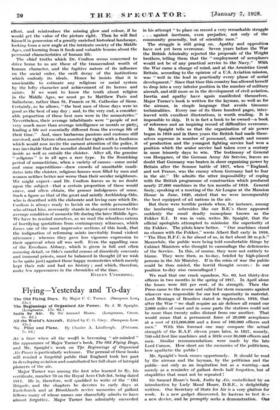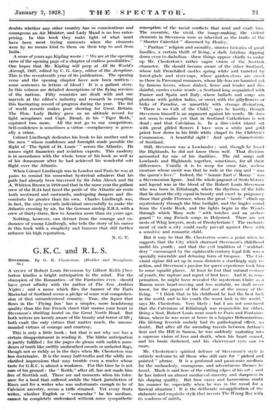Flying—Yesterday and To-day
The Beginnings of Organised Air Power. By J. M. Spaight.
Samuel Hoare. (Longmans, Green.
tis. 6d.) All the World's Aircraft. 42s.)
We --Pilot and Plane. 7s. 6d.) AT a time when all the wor)1 is becoming air-minded " the appearance of Major Turner's book, The Old. Flying Days, and Mr. Spaight's work on Tile Beginnings of Organised Air Power is particularly welcome. The perusal of these books wnl remind a forgetful public that England took her part in developing aviation and contributed her full share of intrepid pioneers of the air.
Major. Turner was among the first who learned to fly, his certificate, number 70 on the Royal Aero. Club list, being dated 1911. He is, therefore, well qualified to write of the " Old Brigade, and the chapters he devotes to early days at Ea.stchurch and at Broolclands revive memories of gallant fellows many of whose names one shamefully admits to have almost forgottev. Major Turner has admirably succeeded
in his attempt " to place on record a very remarkable struggle . . . against inertness, even prejudice, not only of the community generally, but of scientific men."
The struggle is still going on. Apathy and opposition have not yet been overcome. Seven years before the War the British Admiralty rejected the proposals of the Wright brothers, telling them that the " employment of aeroplanes would not be of any practical service to the Navy." With the War came a change of mind, and at the Armistice Great Britain, according to the opinion of a U.S. Aviation mission, was " well in the lead in practically every phase of aerial development." Since that time this country has allowed herself to drop into a very inferior position in the number of military aircraft, and still more so in the development of civil aviation. Inertia and apathy have again manifested themselves. Major Turner's book is written for the layman, as well as for the airman, in simple language that avoids tiresome technicalities. Every one of its three hundred pages, inter- leaved with excellent illustrations, is worth reading. It is impossible to skip. It is in fact a book to be owned—a book of reference and an inspiring record of difficulties overcome.
Mr. Spaight tells us that the organization of air power began in 1916 and in three years the British had made them- selves supreme in number of personnel, aircraft and means of production and the youngest fighting service had won a position which the senior service had taken over a century in more leisurely days to win. The testimony of General von Hoeppner, of the German Army Air Service, leaves no doubt that Germany was beaten in sheer organizing power by Britain after the Somme battle of 1917, when " England, and not France, was the enemy whom Germany had to fear in the air." He admits the utter impossibility of coping with the British programme of construction which produced nearly 27,000 machines in the ten months of 1918. General Seely, speaking at a meeting of the Air League at the Mansion House in June, 1920, stated that we were incomparably the best equipped of all nations in the air.
But there were terrible periods when, for instance, among the lumbering sobersides like our B.E.'s there appeared suddenly the small deadly monoplane known as the Fokker E.I. It was in vain, writes Mr. Spaight, that the official apologists attempted to minimize the superiority of the Fokker. The pilots knew better. " Our machines stand no chance with the Fokker," wrote Albert Ball early in 1916. " The Hun R.F.C. is far ahead of us, in fact about 80 m.p.h." Meanwhile, the public were being told comfortable things by Cabinet Ministers who thought to camouflage the deficiencies of the Service. In this, of course, they were not entirely to blame. They were then, as to-day, briefed by high-placed persons in the Air Ministry. If in the crisis of war the public could be thus misled, the horrid thought occurs : Is our position to-day also camouflaged ?
We read that one crack squadron, No. 60, lost thirty-five officers in two months in the spring of 1917. In April alone the losses were 105 per cent. of its strength. Then the Press came to the rescue and called for stern measures against whoever was responsible for our lost superiority in material-. Lord Montagu of Beaulieu stated in September, 1916, that after the War " we shall require an air defence all round our 2,000 miles of coast and in some parts the stations could not be more than twenty miles distant from one another. That would mean that a permanent force of 20,000 aeroplanes at a cost of £15,000,000 and a force of 160,000 officers and men." With this forecast one may compare the actual strength of the R.A.F. eleven years later, in 1927, namely, 700 odd first line machines and a little over 30,000 officers and men. Similar recommendations were made by the late Lord.Curzon. How short are the memories of the politicians, how apathetic the public !
Mr. Spaight's book conies opportunely. It should be read by the airman and the layman, by the politician and the public—not only as an inspiration but as a warning—not merely as a reminder of gallant deeds half forgotten, but of stupidities that must not be repeated
Sir Samuel Hoarels book, India by Air, embellished by an introduction by Lady Maud Hoare, D.B.E., is delightfully written: Our Secretary of State for Air is a very glutton for work. Is a new gadget discovered, he hastens to test it— a new -device, and he promptly seeks a demonstration. One
doubts whether any other country has so conscientious and courageous an Air Minister, and Lady Maud is no less enter- prising. In this book they make light - of what must have been most trying moments when the elements were by no means kind to them on their trip to and from India, A score of years ago Kipling wrote : " We are at the opening curse of the opening page of a chapter of endless possibilities." One hopes that . Mr. Kipling will peep at All the World's Aircraft, 1927, edited by C. G. Grey, editor of the Aeroplane. This is .the seventeenth year of its publication. The opening verse and the opening chapter have now been written— some sentences in letters of blood ! It is a gallant story. In this volume are detailed descriptions of the flying services of the nations. Fifty countries are dealt with and one marvels at the editor's industry and research in compiling this fascinating record of progress during the year. The list of world records makes poor showing for Great Britain. The lion. Lady Bailey gave us an altitude record for light aeroplanes and Capt. Broad, in his " Tiger Moth," captured two more. All the rest go to our competitors. Self-confidence is sometimes a virtue--complacency is gener- ally a crime.
Colonel Lindbergh dedicates his book to his mother and to the men " whose confidence and foresight made possible the flight of "The Spirit of St. Louis ' " across the Atlantic. He names eight financiers and aviation experts. This modesty is in accordance with the whole tenor of his book as well as of his demeanour after he had achieved his wonderful solo flight_ over the Atlantic.
When Colonel Lindbergh was in London and Paris he was at pains to remind his somewhat hysterical admirers that his path had already been traversed by Sir John Alcock and Sir A. Whitten Brown in 1919 and that in the same year the gallant crew of the R.84 had faced the perils of the Atlantic air route both westward and eastwards, undergoing dangers and dis- comforts far greater than his own. Charles Lindbergh was; in fact, the sixty-seventh individual successfully to make the Atlantic crossing by air, for the German airship Z.R.3, with a crew of thirty-three, flew to America more than six years ago.
Nothing, however, can detract from the courage and en- durance 'of young Lindbergh, who tells the story of his career in this book with a simplicity and humour that still further enhance his high reputation.
N. G. T.







































 Previous page
Previous page